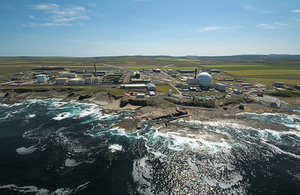Offshore clean-up completes 90 hectares of seabed
Another 299 particles were recovered from the seabed off Dounreay this summer during the latest phase of offshore clean-up.

Dounreay
Land and Marine was again contracted to deploy its 1500-tonne barge and remotely-operated vehicle and started work on May 24. This year’s objective was to cover approximately 36 hectares of seabed agreed with the independent experts of the Particles Retrieval Advisory Group.
The round-the-clock operation, which included specialist health physics firm Nuvia, ended last month when the company had covered a total of 42 hectares of seabed.
This included an area to the east of the fishing exclusion zone. DSRL wishes to express its gratitude to local fishermen for their co-operation during this work.
A total of 299 particles were recovered, of which 16 were considered “significant” in terms of health risk, 54 were “relevant” and 229 were “minor”. * The largest single find measured 7.6MBq of Caesium-137.
It takes the total area of seabed monitored by ROV to more than 90 hectares since the programme was agreed in 2008 following extensive consultation.
The area of seabed containing “significant” particles and identified by the advisory group’s predecessor measures 60 hectares. This means some areas of the plume have now been surveyed more than once by ROV.
The total number of particles now recovered from the seabed is 2184, of which 409 are sufficiently radioactive to be considered “significant”.
DSRL continued to work closely during this year’s clean-up with the Particles Retrieval Advisory Group, which advises both SEPA and the site during the clean-up phase.
As the work progressed, the group was able to review the results and aid the site team on the focus of their work, including areas beyond the boundary of the initial plume.
A report on this year’s programme is now being compiled for the advisory group and this will inform its discussion about any further work that may be needed to reduce the risk from particles in the marine environment.
Particles on the seabed are believed to have been released into the sea in discharges from the reprocessing of spent fuel as long ago as the early 1960s. See our particles section for more information.
- Figures amended on September 17, 2012, as a result of more detailed analysis.